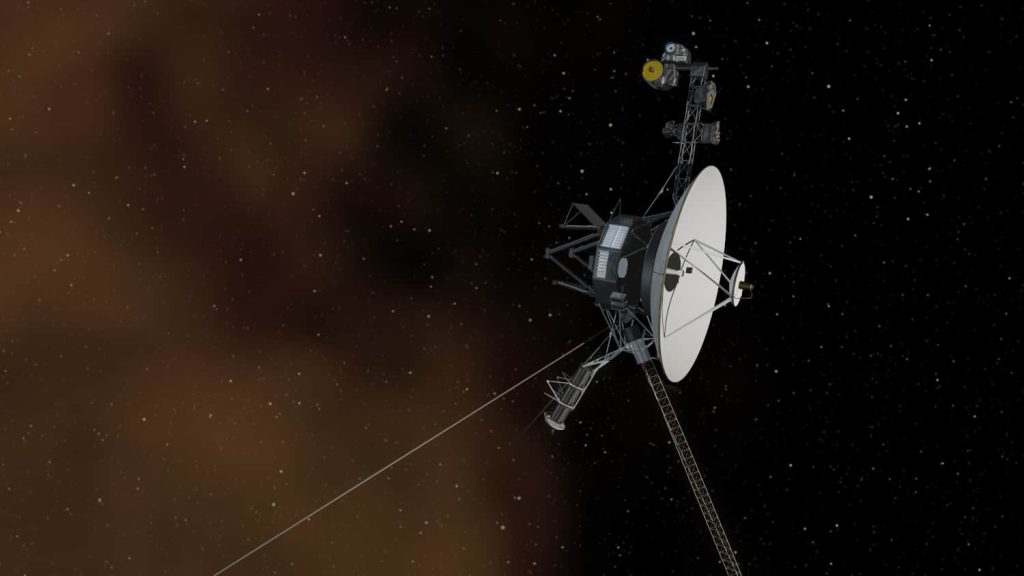
NASA receives strange data from the Voyager 1 probe
Voyager 1, one of two space probes launched in 1977 to explore the distant regions of our solar system, is still in operation. It is currently more than 23 billion km from Earth and regularly transmits new data. But recently, the team in charge of the mission noticed an anomaly: the telemetry data from the craft turned out to be inconsistent.
The Voyager 1 probe was launched on September 5, 1977, and the main mission was to explore the planetary systems of Jupiter and Saturn. These forty-five years of good and faithful service have made tremendous scientific progress possible; The data transmitted by the probe remarkably made it possible to observe the rings of Jupiter for the first time, to shed light on the functioning of the famous Great Red Spot and learn more about the structure of Io and Europa.
The exploration instrument also revealed the exact structure of Saturn’s rings, confirming the existence of the dark bands (aka speaker) is perpendicular to the loops and reveals the presence of additional loops. In 1980, when it arrived near Titan, the probe made it possible to determine the composition of the atmosphere of this moon – many other small moons have also been discovered. It may seem inconceivable that the probe instruments are still working after so many years. But it’s possible that Voyager 1 is showing the first signs of fatigue…
A ‘normal’ problem after a 45-year journey
The probe appears to be operating normally; Anyway, it receives and executes commands sent from Earth, collects data and sends it back to the mission team as expected. However, data on the expression and position control system (AACS) are atypical. This system is responsible for controlling the direction of the probe; In particular, he must ensure that the communication antenna is always directed towards the ground. While it still appears to work, the telemetry data it displays is inconsistent.
The signal returned by the probe did not attenuate, indicating that the antenna was still pointed in the correct direction. Scientists also noted that this anomaly did not trigger the protection system that is responsible for turning the device into “safety mode” at the slightest malfunction. So the team has no idea yet on the origin of the problem and doesn’t know whether or not this will affect the life of the device.
” This ambiguity is normal at this point in the Voyager mission. ”, Susan Dodd said, project manager of Voyager 1 and 2 at the Jet Propulsion Laboratory. In fact, as the scientist reminds us, the two Voyager sensors have far exceeded their initially planned operational life (10 years!). In addition, since August 2012, the probes have been in interstellar space and therefore experience a high level of cosmic radiation.
The source of the deviation is either the AACS itself or another system involved in the production and transmission of telemetry data. If the problem is identified, it can be resolved by modifying the offending software or by using rescue devices. The distance clearly does not make the task easier: light currently takes 20 hours and 33 minutes to travel more than 23 billion kilometers from the probe. Therefore, scientists must suffice with 41 hours of latency between sending their instructions and receiving a response…
Three more years of data to exploit
Note that this isn’t the first time Voyager 1 has experienced a technical failure. In 2014, NASA engineers noticed that the probe’s thrusters — which are used to maintain its orientation, via pulses as small as a few milliseconds — began to deteriorate. To avoid collapse, the team decided in 2017Ignite four more batches… that you haven’t used in 37 years! And the operation was a success: the probe finally gained a few more years of life.

Both Voyager sensors produce about 4 watts less electrical energy per year, which limits the number of systems the vehicle can operate. Thus, to save energy, many tools have already been deactivated voluntarily over the years. Remote sensors, such as the interferometer, infrared radiometer and ultraviolet spectrophotometer are turned off; Low-energy cosmic ray and particle detectors are still active.
Voyager 1 is the first man-made object to be operated interstellar space exploration ; It is moving away from the solar system at a rate of 3.6 AU per year. Its dual probe has been doing the same thing since the end of 2018. They are expected to remain operational until at least 2025, after which, due to electricity and fuel shortages, they will not be able to collect and transmit data. to ground. Until then, scientists will try to make the most of the data collected by the two devices.
In 40,000 years, Voyager 1 will drift less than 1.6 Light year From Gliese 445, a star in the constellation Giraffe. At the same time, Voyager 2 will pass about 1.7 light-years from the star Ross 248 and in about 296 thousand years (!) It will move to 4.3. light years Sirius, the brightest star in the sky after the sun.
source : NASA

“Incurable web evangelist. Hipster-friendly gamer. Award-winning entrepreneur. Falls down a lot.”
